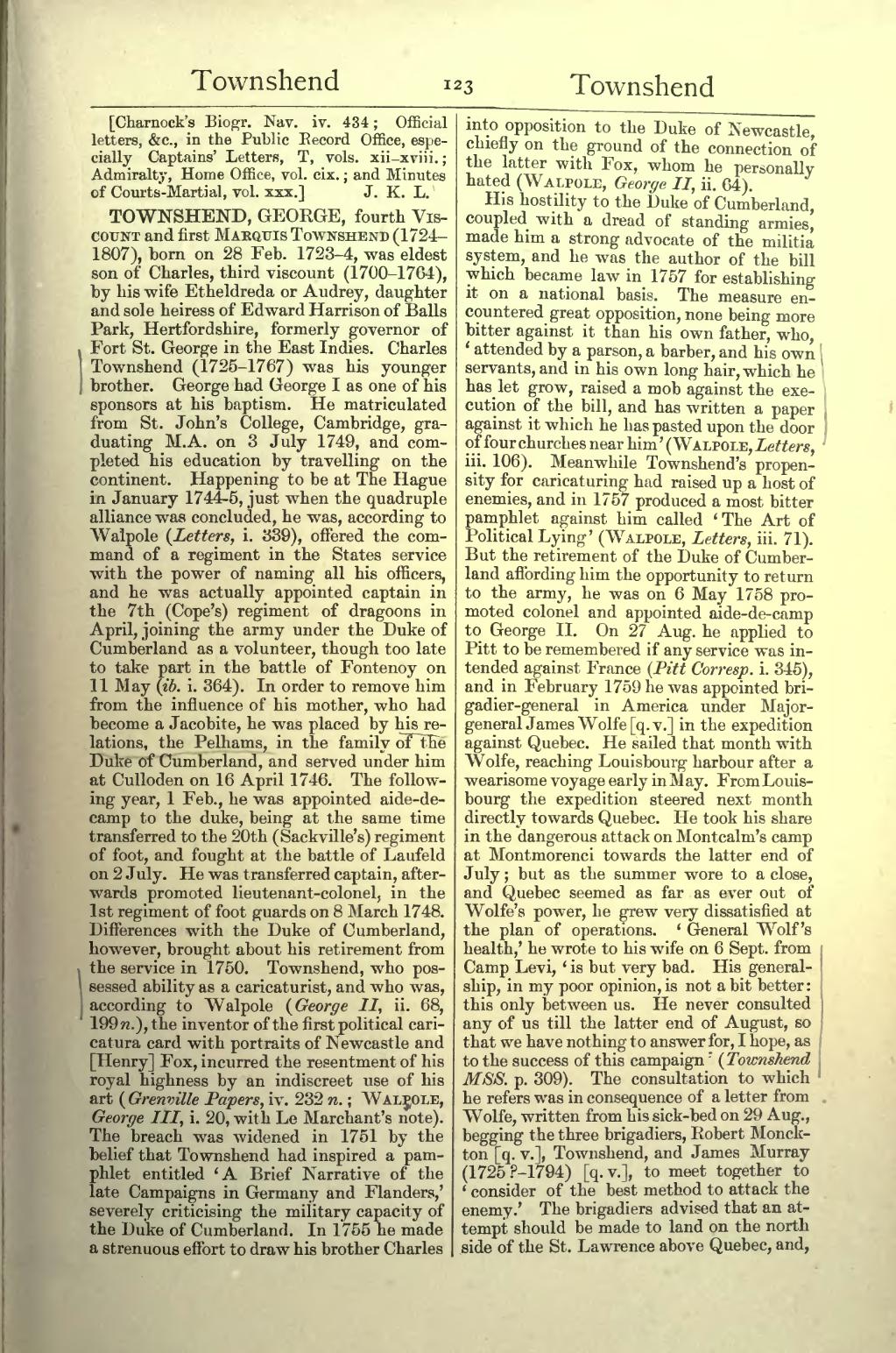[Charnock's Biogr. Nav. iv. 434; Official letters, &c., in the Public Record Office, especially Captains' Letters, T, vols. xii–xviii.; Admiralty, Home Office, vol. cix.; and Minutes of Courts-Martial, vol. xxx.]
TOWNSHEND, GEORGE, fourth Viscount and first Marquis Townshend (1724–1807), born on 28 Feb. 1723–4, was eldest son of Charles, third viscount (1700–1764), by his wife Etheldreda or Audrey, daughter and sole heiress of Edward Harrison of Balls Park, Hertfordshire, formerly governor of Fort St. George in the East Indies. Charles Townshend (1725–1767) was his younger brother. George had George I as one of his sponsors at his baptism. He matriculated from St. John's College, Cambridge, graduating M.A. on 3 July 1749, and completed his education by travelling on the continent. Happening to be at The Hague in January 1744–5, just when the quadruple alliance was concluded, he was, according to Walpole (Letters, i. 339), offered the command of a regiment in the States service with the power of naming all his officers, and he was actually appointed captain in the 7th (Cope's) regiment of dragoons in April, joining the army under the Duke of Cumberland as a volunteer, though too late to take part in the battle of Fontenoy on 11 May (ib. i. 364). In order to remove him from the influence of his mother, who had become a Jacobite, he was placed by his relations, the Pelhams, in the family of the Duke of Cumberland, and served under him at Culloden on 16 April 1746. The following year, 1 Feb., he was appointed aide-de-camp to the duke, being at the same time transferred to the 20th (Sackville's) regiment of foot, and fought at the battle of Laufeld on 2 July. He was transferred captain, afterwards promoted lieutenant-colonel, in the 1st regiment of foot guards on 8 March 1748. Differences with the Duke of Cumberland, however, brought about his retirement from the service in 1750. Townshend, who possessed ability as a caricaturist, and who was, according to Walpole (George II, ii. 68, 199 n.), the inventor of the first political caricatura card with portraits of Newcastle and [Henry] Fox, incurred the resentment of his royal highness by an indiscreet use of his art (Grenville Papers, iv. 232 n.; Walpole, George III, i. 20, with Le Marchant's note). The breach was widened in 1751 by the belief that Townshend had inspired a pamphlet entitled ‘A Brief Narrative of the late Campaigns in Germany and Flanders,’ severely criticising the military capacity of the Duke of Cumberland. In 1755 he made a strenuous effort to draw his brother Charles into opposition to the Duke of Newcastle, chiefly on the ground of the connection of the latter with Fox, whom he personally hated (Walpole, George II, ii. 64).
His hostility to the Duke of Cumberland, coupled with a dread of standing armies, made him a strong advocate of the militia system, and he was the author of the bill which became law in 1757 for establishing it on a national basis. The measure encountered great opposition, none being more bitter against it than his own father, who, ‘attended by a parson, a barber, and his own servants, and in his own long hair, which he has let grow, raised a mob against the execution of the bill, and has written a paper against it which he has pasted upon the door of four churches near him’ (Walpole, Letters, iii. 106). Meanwhile Townshend's propensity for caricaturing had raised up a host of enemies, and in 1757 produced a most bitter pamphlet against him called ‘The Art of Political Lying’ (Walpole, Letters, iii. 71). But the retirement of the Duke of Cumberland affording him the opportunity to return to the army, he was on 6 May 1758 promoted colonel and appointed aide-de-camp to George II. On 27 Aug. he applied to Pitt to be remembered if any service was intended against France (Pitt Corresp. i. 345), and in February 1759 he was appointed brigadier-general in America under Major-general James Wolfe [q. v.] in the expedition against Quebec. He sailed that month with Wolfe, reaching Louisbourg harbour after a wearisome voyage early in May. From Louisbourg the expedition steered next month directly towards Quebec. He took his share in the dangerous attack on Montcalm's camp at Montmorenci towards the latter end of July; but as the summer wore to a close, and Quebec seemed as far as ever out of Wolfe's power, he grew very dissatisfied at the plan of operations. ‘General Wolf's health,’ he wrote to his wife on 6 Sept. from Camp Levi, ‘is but very bad. His generalship, in my poor opinion, is not a bit better: this only between us. He never consulted any of us till the latter end of August, so that we have nothing to answer for, I hope, as to the success of this campaign’ (Townshend MSS. p. 309). The consultation to which he refers was in consequence of a letter from Wolfe, written from his sick-bed on 29 Aug., begging the three brigadiers, Robert Monckton [q. v.], Townshend, and James Murray (1725?–1794) [q. v.], to meet together to ‘consider of the best method to attack the enemy.’ The brigadiers advised that an attempt should be made to land on the north side of the St. Lawrence above Quebec, and,
